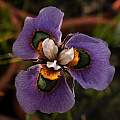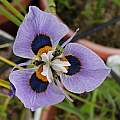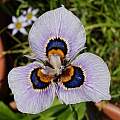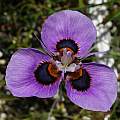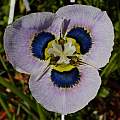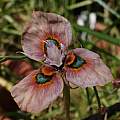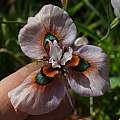A prominent species in my Moraea breeding program is Moraea villosa. It's a beautiful species, with by far the widest variety of colors in the genus. For breeding purposes, I needed to keep track of the M. villosa color forms I was using in crosses. So I started labeling them. This is not an official classification of the species, and you should not misread these color forms as some sort of subspecies. They're just different individuals picked out from a very variable species.
They will, though, give you an idea of the sort of colors you might get if you grow these plants.
I've grouped the plants by the main color of their tepals (the larger petals):
Dark purple tepals
Moraea villosa H: Dark purple tepals, green eye, orange center. This is the darkest purple of all my villosa forms, with vivid green eyes. This flower really stands out when you see it in person. It came to me in a batch of mixed flowers labeled as a variety called 'Champagne Ice.' I have no idea what Champagne Ice is supposed to look like, but I doubt this is it. But who cares, it's a striking flower.
Medium purple-blue tepals
Moraea villosa A (first photo): Violet tepals, bright blue eye, orange center. I think of this as the classic Moraea villosa color scheme.
Moraea villosa A+ (second photo): Violet tepals, blue eye with black ring, orange center. This one is similar to villosa A, but the tepals have more prominent veins, and the eye of the flower has a back ring around it. It looks very distinctive when seen in person.
Moraea villosa G (third photo): Violet tepals, very dark blue eye, orange center. This one looks a lot like form A, so I was not sure whether to give it a separate letter. But the eye is indigo, almost black, instead of bright blue. So I decided I should keep it separate.
Moraea villosa B (fourth photo): Violet tepals, blue eye, lemon yellow center. This is another common M. villosa color form in cultivation.
Moraea villosa B+ (fifth photo): Violet tepals, blue eye with dark rim, yellow center. This is very similar to form B, but with a dark rim around the eye.
Mauve-brown tepals
Moraea villosa D: Mauve tepals, blue-green eye, orange center. I think of this as a chocolate Moraea. In bud, it looks solid brown. When the flower opens (first photo), the tepals are the color of hot chocolate with a bit of whipped cream in it. In a few days (second photo) they fade to the color of face powder. It is the strangest form of Moraea villosa I've seen.
Pale violet-pink tepals
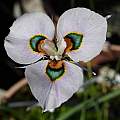
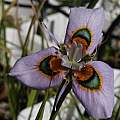
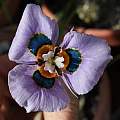

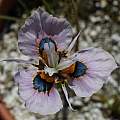
(It's hard to tell the difference between pale violet and pale pink, so I grouped them together.)
Moraea villosa C (first photo): Light purple tepals, teal/green eye, orange center. The purple in the tepals fades to almost-white after a few days.
Moraea villosa J (second photo): Pale violet tepals, blue-green eye with strong orange rim, orange center. This one is very similar to form C, but the rim is very prominent in person, so I decided to give it a separate letter.
Moraea villosa E (third photo): Pale violet tepals, blue eye, orange center. Similar colors to form C, but without the strong ring around the eye.
Moraea villosa I (fourth flower): Pale violet tepals, blue eye with a dark green rim, yellow center. This one's similar to M. villosa E, but with a lemon yellow center. (This photo is overexposed; in real life the tepals are pale violet.)
Moraea villosa K (fifth photo): Pale mauve-pink tepals, blue eye, orange center.
White tepals
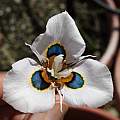
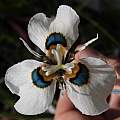
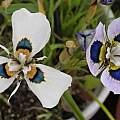
Moraea villosa F (first two photos): White tepals, blue eye, orange center. This one is white. Not faded pale purple or light violet, it's just plain white. Some longtime growers in South Africa tell me they haven't seed a white form of M. villosa in the wild, so some people speculate that maybe this is an accidental cross with M. aristata. I can't rule that out, but Goldblatt's book on the genus says that M. villosa can be found in white, and the flowers of this plant do not show the other characteristics of M. aristata (for example, dots on the backs of the tepals). I have two clones of this color form, from different sources (note the difference in tepal width between the first and second photo). I crossed them in 2012, and they set seed. If they are hybrids, that should show up in the offspring. The third photo gives you a better idea of how white Moraea villosa F is; it's shown next to Moraea villosa B.
Return to the Peacock Moraea Hybrids index
Galaxia - Gynandriris - Hexaglottis - Homeria A-J - Homeria K-Z - Moraea group A - Moraea group B - Moraea group C-E - Moraea group F - Moraea group G-I - Moraea group J-M - Moraea group N-R - Moraea group S - Moraea group T - Moraea group U-V - Moraea index
